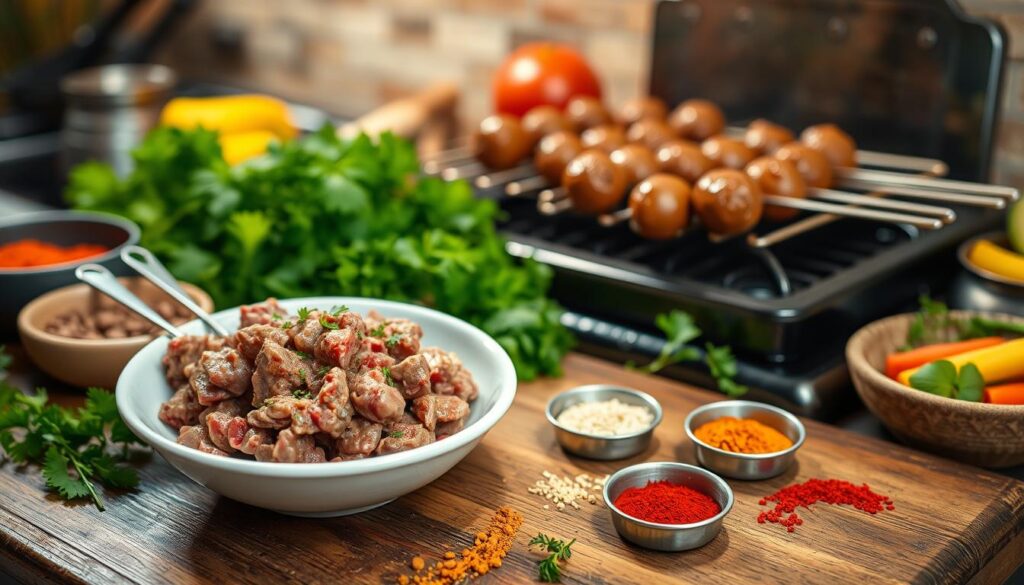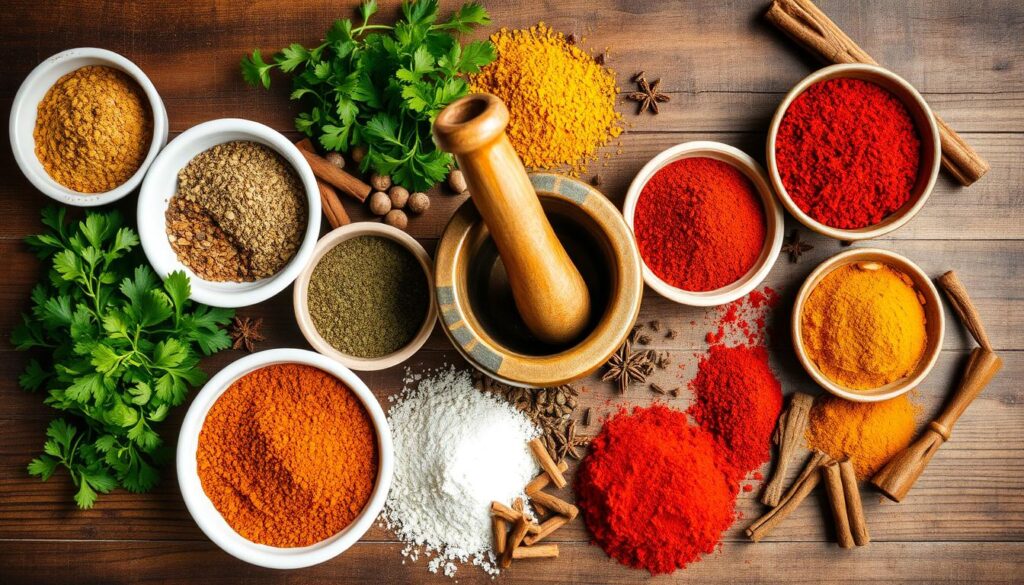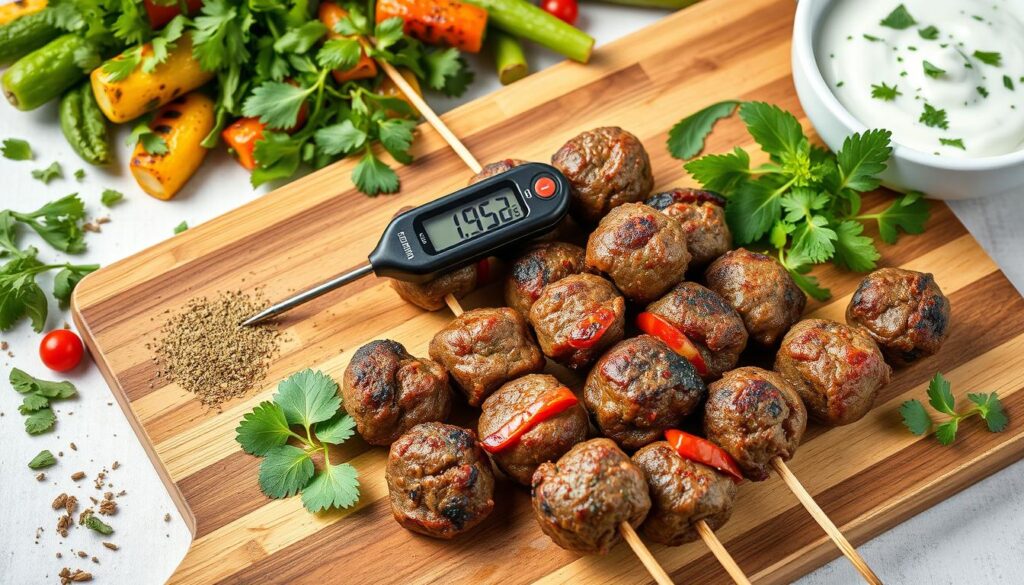
Discover the art of making authentic Middle Eastern meatballs with this detailed guide. You’ll learn how to turn simple ingredients into a delicious dish. This dish captures the heart of traditional Middle Eastern cuisine.
Whether you’re cooking at home or love trying new recipes, mastering lamb kofta is key. This guide will show you how to make kofta that will wow your family and friends.
Key Takeaways
- Learn authentic lamb kofta preparation methods
- Understand the importance of proper meat selection
- Master traditional Middle Eastern seasoning techniques
- Explore multiple cooking methods for perfect kofta
- Discover tips for maintaining moisture and flavor
- Gain insights into cultural cooking traditions
Understanding Traditional Middle Eastern Kofta Origins
Kofta is a culinary treasure from Middle Eastern cuisine. It has a rich history of cultural traditions and flavors. Exploring kofta history opens a world of culinary craftsmanship.
The origins of kofta take you through a colorful world of culinary traditions. It started in the ancient Mashawi barbecue culture. Here, meat preparation was an art form passed down through generations.
Historical Roots of Kofta Making
Kofta’s roots go back to the Persian Empire. Skilled cooks there developed meat preparation techniques. Traditional spices like cumin, coriander, and cinnamon gave the dish its unique flavor.
- Persian culinary influence
- Nomadic cooking traditions
- Spice trade connections
Regional Variations Across Cultures
Regions developed their own kofta styles, using local ingredients and cooking methods. From the Levant to North Africa, each culture added its own twist to this versatile dish.
| Region | Kofta Characteristic | Signature Spices |
|---|---|---|
| Lebanon | Lighter, more delicate | Cinnamon, allspice |
| Turkey | Robust, grilled style | Red pepper, cumin |
| Egypt | Spicier preparation | Coriander, parsley |
Traditional Spice Combinations
The magic of kofta is in its spice blends. Chefs mix traditional kofta spices to create layers of flavor. This turns simple ground meat into a culinary masterpiece.
“Spices are the soul of kofta, telling stories of generations through their aromatic complexity.” – Middle Eastern Culinary Historian
Knowing these historical details helps us see kofta as more than a dish. It’s a cultural expression of Middle Eastern cuisine’s rich heritage.
Essential Ingredients for Perfect Lamb Kofta
Making great lamb kofta starts with picking the right ingredients. The base of a tasty kofta is your ground lamb quality and the right aromatics. When making this Middle Eastern dish, use fresh, top-notch ingredients for rich, true flavors.
Choosing the right ground lamb is key. Look for meat with about 20% fat. This keeps your kofta juicy and tender. Buy freshly ground lamb from a good butcher or meat market.
Essential Ingredients List
- Ground lamb (1/2 pound recommended)
- Fresh herbs for kofta: Parsley and dill
- Kofta aromatics: Onions and garlic
- Signature spices:
- Cumin
- Coriander
- Paprika
- Cinnamon
“The secret to remarkable kofta is balancing your fresh herbs and spices with high-quality meat.” – Mediterranean Cooking Expert
Choose fresh parsley and dill for your kofta. These herbs add a bright, fresh taste that balances the lamb’s richness. Chop them finely so the flavors mix well with the meat.
Onions and garlic are key for flavor. They turn simple meat into a flavorful dish. Use a sharp knife to mince them finely for the best taste.
Play with spice amounts to find your favorite taste. Traditional recipes are a good start, but feel free to adjust the spices to your liking.
Lamb Kofta Cooking Techniques
Learning to cook lamb kofta is all about mastering different techniques. These methods help bring out the best flavors and textures. Whether you’re cooking at home or in a professional kitchen, trying out various cooking methods will make your kofta better.
Grilling Methods for Perfect Kofta
Grilling lamb kofta can make your dish go from good to great. Start by heating your grill to medium-high heat. Aim for a temperature of 400°F (200°C). Make your kofta logs about 13cm (5 inches) long and 1.25cm (0.5 inches) thick for even cooking.
- Grill each side for 2-3 minutes until nicely browned
- Rotate kofta to achieve perfect grill marks
- Use 8 skewers of 18cm (7 inches) length for consistent results
Pan-Fried Kofta Perfection
Pan-frying kofta is a tasty option when you can’t grill outside. Use a cast-iron skillet or heavy-bottomed pan for even heat. It takes about 10 minutes to cook the kofta in a pan.
“The secret to perfect pan-fried kofta is maintaining consistent medium-high heat and turning them carefully to preserve their shape.”
Oven-Baking Techniques for Lamb Kofta
Oven-baking lamb kofta is a hands-off method that works well. Preheat your oven to 400°F (200°C) and place the kofta on a baking sheet. Bake for 20-25 minutes, until the meat reaches 160°F for perfect doneness.
| Cooking Method | Temperature | Cooking Time |
|---|---|---|
| Grilling | 400°F | 2-3 minutes per side |
| Pan-Frying | Medium-High | 10 minutes total |
| Oven-Baking | 400°F | 20-25 minutes |
No matter the method, perfect lamb kofta needs attention to detail, consistent heat, and the right seasoning.
Mastering the Art of Kofta Seasoning
Making the perfect kofta spice blend is an art. It turns simple lamb into a delicious dish. Knowing how to season is key to balancing flavors that enhance the meat’s taste.

- Cumin: Provides earthy warmth
- Coriander: Adds citrusy undertones
- Paprika: Introduces subtle sweetness
- Cinnamon: Brings depth and complexity
“The secret to perfect kofta lies in understanding how each spice contributes to the overall flavor profile.”
To balance flavors, pay close attention to the amounts. Start with small amounts and adjust to your taste. Use about ½ teaspoon of each spice for every 300g of lamb.
| Spice | Quantity | Flavor Profile |
|---|---|---|
| Ground Cumin | ½ tsp | Earthy, warm |
| Ground Coriander | ½ tsp | Citrusy, bright |
| Smoked Paprika | ½ tsp | Sweet, smoky |
| Ground Cinnamon | ¼ tsp | Warm, complex |
For those who like to try new things, add spices like Aleppo pepper or sumac. This can add unique flavors. Make sure to mix the seasonings well into the meat for even flavor.
Shaping and Forming Perfect Kofta
Learning how to shape kofta is key to making tasty lamb kofta. It’s all about precision and technique. This ensures even cooking and the best flavor.
When making your kofta, focus on the size and shape. Chefs say to make them 4 inches long and 1 inch wide. This size helps them cook evenly and look great.
Traditional Cylinder Shapes
To get the right kofta shape, follow these steps:
- Use slightly wet hands to prevent meat mixture from sticking
- Roll meat gently between palms to create smooth cylinders
- Maintain consistent pressure while shaping
- Aim for uniform thickness throughout the kofta
Skewered Kofta Techniques
For skewered kofta, you need to prepare extra. Soak wooden skewers in water for about 30 minutes. This stops them from burning.
| Skewering Tips | Details |
|---|---|
| Skewer Material | Bamboo or metal recommended |
| Skewer Preparation | Soak wooden skewers for 30 minutes |
| Kofta Attachment | Gently press meat onto skewer |
Size and Thickness Guidelines
It’s important to keep the kofta size consistent. Each piece should be about 2 ounces (50 grams). Shape them into cylinders that are 1½ inches wide and 7 inches long.
“The secret to great kofta is in the details of shaping and preparation.” – Middle Eastern Culinary Expert
Remember, the meat’s temperature is crucial for shaping. Work with slightly chilled meat. This makes it easier to handle and shape more accurately.
Temperature Control and Cooking Times
Getting the kofta internal temperature right is key to making delicious, safe lamb kofta. The cooking time affects the taste and texture of this traditional dish. Professional chefs stress the importance of precision in making these tasty meat rolls.

Knowing how to check for doneness is crucial. Here are the main temperature guidelines:
- Rare: 125°F (52°C) – Not recommended for lamb kofta
- Medium-Rare: 135°F (57°C) – Slightly pink center
- Medium: 145°F (63°C) – Recommended safe temperature
- Well-Done: 160°F (71°C) – Fully cooked, no pink
Cooking times depend on your method:
- Grilling: 8-10 minutes total
- Pan-Frying: 10-12 minutes
- Oven-Baking: 15-20 minutes
“The secret to perfect kofta is patience and a reliable meat thermometer.” – Mediterranean Cooking Expert
Here are some pro tips for keeping kofta at the right temperature:
- Always use a digital meat thermometer
- Let kofta rest for 5 minutes after cooking
- Flip kofta halfway through cooking
- Avoid overcrowding the cooking surface
Remember, ground lamb must reach 160°F (71°C) for food safety. Your aim is to make juicy, flavorful kofta that’s perfectly cooked every time.
Serving Suggestions and Accompaniments
Make your lamb kofta meal special with the right side dishes and sauces. These can turn a simple dinner into a fun food adventure. The right choices can bring out the best in your kofta and make your meal unforgettable.
Traditional Kofta Side Dishes
For lamb kofta, try different side dishes to match its strong taste. Here are some favorites:
- Lebanese Rice (cooks in 20 minutes)
- Mediterranean Grilled Vegetables
- Fattoush Salad
- Shirazi Salad
- Golden Rice Pilaf
Middle Eastern Sauces for Perfect Pairings
Try Middle Eastern sauces to elevate your lamb kofta. Here are some tasty ones:
- Tahini Sauce (cooks in 20 minutes)
- Hummus
- Tzatziki
- Harissa
Plating Techniques to Impress
Learn to plate your kofta to make it look amazing. Place skewers on rice, add fresh herbs, and drizzle sauce in patterns. A bit of sumac or parsley can brighten up your dish.
“Great food is an art – and presentation is your canvas.” – Unknown Chef
Remember, serving lamb kofta is about more than just food. It’s about creating a memorable experience. With these tips, you’ll make your meal a journey to remember.
Troubleshooting Common Kofta Problems
Making perfect lamb kofta can be tough, even for skilled cooks. Kofta texture issues often come from simple mistakes. These can be fixed with the right methods.
To avoid dry kofta, know your meat. Use a mix of 80% lean meat and 20% fat. When mixing, be gentle to avoid making the meat tough and dry.
- Use freshly ground meat from a butcher for optimal texture
- Add fat content carefully to maintain moisture
- Mix ingredients minimally to prevent dense kofta
To fix flavor problems, try these strategies:
- Add a teaspoon of salt per pound of meat
- Incorporate breadcrumbs with proper hydration
- Experiment with spice combinations
“A test kofta can reveal potential issues before cooking the entire batch” – Culinary Expert
When cooking, watch the temperature closely. For air fryers, use 200°C/400°F for 12 minutes. Always cook a test piece first to check seasoning and texture.
Remember, practice is key. Every try gets you closer to making delicious, moist lamb kofta.
Conclusion
Your journey into lamb kofta techniques has given you valuable skills in Middle Eastern cooking. You now know how to turn simple ingredients into amazing dishes. This knowledge goes beyond just cooking.
Learning kofta techniques is more than just following a recipe. It’s about diving into cultural traditions and trying new flavors. It’s about understanding the mix of spices and cooking methods. Each kofta you make shares a story of culinary heritage and your creativity.
As you keep practicing, you’ll see how versatile lamb kofta can be. You can grill it quickly or adjust recipes for different diets. Your skills will let you make dishes that wow everyone you share them with.
Keep exploring and stay curious. Enjoy the journey of discovering Middle Eastern cuisine through lamb kofta. It’s a delicious adventure.
FAQ
What is lamb kofta?
Lamb kofta is a dish from the Middle East. It’s made from ground lamb mixed with spices, herbs, and aromatics. The meat is shaped into long, thin cylinders. It’s known for its rich flavor and can be cooked in many ways.
What are the key spices used in traditional lamb kofta?
The spices in lamb kofta include cumin, coriander, cinnamon, parsley, and mint. These spices give the lamb a complex and aromatic flavor. The exact mix can vary by region in the Middle East.
What are the best cooking methods for lamb kofta?
You can cook lamb kofta by grilling, pan-frying, or baking. Grilling adds a smoky taste and nice char marks. Pan-frying is good for indoor cooking. Baking is easy and hands-off, making sure the kofta is juicy.
How do I prevent my lamb kofta from becoming dry?
To keep kofta moist, use lamb with 15-20% fat. Don’t overwork the meat and don’t overcook it. Adding fresh herbs or breadcrumbs helps. Always check the meat’s temperature with a thermometer.
What are some traditional side dishes to serve with lamb kofta?
Serve lamb kofta with tabbouleh, fattoush salad, hummus, tzatziki sauce, pita bread, and roasted vegetables. These sides enhance the flavors of the kofta and offer a complete Middle Eastern meal.
Can I make lamb kofta ahead of time?
Yes, you can make kofta ahead. Shape the meatballs and refrigerate them for up to 24 hours. You can also freeze them for a month. Just wrap them well to avoid freezer burn.
What’s the ideal internal temperature for cooked lamb kofta?
Cook lamb kofta to an internal temperature of 160°F (71°C). Use a meat thermometer to check. This ensures the kofta is safe to eat and juicy.
Are there vegetarian alternatives to lamb kofta?
Yes, you can make vegetarian kofta with ground chickpeas, lentils, mushrooms, or plant-based meat. These alternatives have different textures and flavors but still capture the dish’s essence.

